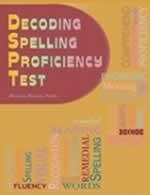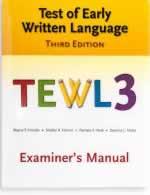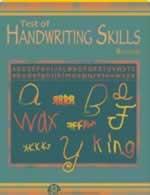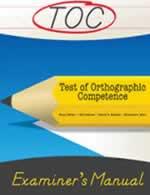TEWL-3: Test of Early Written Language-Third Edition
Interest Level:
Additional Components:
Test, Manual, Picture Cards, Student Workbooks and Record Booklets
This product requires a check of customer qualifications.
CLICK HERE to download qualifications form.
Testing Time: 30-50 minutes Administration: Individual The TEWL-3 is a revision of the widely used Test of Early Written Language Second Edition. It includes two forms, each with a Basic Writing and a Contextual Writing subtest. The TEWL-3 is suitable as an individual assessment instrument for children ages 4-0 to 11-11. The TEWL-3 provides standard score indexes (M = 100, SD = 15) for age and grade percentiles, and age and grade equivalents. The selection of items and the...
Testing Time: 30-50 minutes
Administration: Individual
Administration: Individual
The TEWL-3 is a revision of the widely used Test of Early Written Language Second Edition. It includes two forms, each with a Basic Writing and a Contextual Writing subtest. The TEWL-3 is suitable as an individual assessment instrument for children ages 4-0 to 11-11. The TEWL-3 provides standard score indexes (M = 100, SD = 15) for age and grade percentiles, and age and grade equivalents.
The selection of items and the development of the subtests are grounded in the available research literature and other evidence of developing literacy ability, including curriculum guides and classroom activities. Item types were selected only if recognized experts in the field have related them to developing literacy abilities. Though using a different format, the TEWL-3 is a companion to the TOWL 4 and extends the assessment range to younger children.
TEWL-3 Subtests and Composite
Basic Writing. This subtest consists of 70 items that are scored 0, 1, or 2. All items are presented according to increasing difficulty. This subtest measures a child’s understanding about language and his or her ability to use the writing tools of language. Included in this understanding is metalinguistic knowledge, directionality, organizational structure, awareness of letter features, spelling, capitalization, punctuation, proofing, sentence combining, and logical sentences. The Basic Writing subtest can be administered independently or in conjunction with the Contextual Writing subtest. Age-based norms are provided for children from ages 4-0 through 11-11. Grade-based norms are provided for Grades 2 through 6.
Contextual Writing. This subtest consists of 20 items that are scored 0 to 3. Two sets of pictures are provided, one for younger children (ages 5-0 through 6-11) and one for older children (ages 7-0 through 11-11). This subtest measures a child’s ability to construct a story when provided with a picture prompt. The subtest measures story format, cohesion, thematic maturity, ideation, and story structure. A detailed, expanded scoring guide is provided to assist in scoring the Contextual Writing subtest. This subtest can also be administered independently or in conjunction with the Basic Writing subtest. Age-based norms are provided for children ages 5-0 through 11-11. Grade-based norms are provided for Grades 2 through 6.
Overall Writing. The Overall Writing index combines the index scores from the Basic Writing and Contextual Writing subtests. It is a measure of the child’s overall writing ability; students who score high on this quotient demonstrate strengths in composition, syntax, mechanics, fluency, cohesion, and the text structure of written language. This score can only be computed if the child completes both subtests and is at least 5 years of age.
Normative Characteristics
The TEWL-3 norms represent more than 2,085 children from 30 states and British Columbia, Canada. Characteristics of the normative group correspond to those for the 2010 census data relative to geographic region, gender, ethnicity, Hispanic status, household income, educational attainment of parents, and exceptionality status. Item sequence was determined by item difficulty and item discrimination.
TEWL-3 Reliability
- For age and grade, internal consistency reliability (alpha) coefficients of all scores meet or exceed .90 for all ages, with most meeting or exceeding .95.
- For alternate form reliability, only 4 of 42 coefficients do not meet or exceed .90. Of the four, all are in the mid to high 80s.
- Stability reliability of all scores approximates or exceeds .90.
- Across all forms of reliability, the reliability of the composite index is in the mid to high 90s.
TEWL-3 Validity
- Extensive content validity data are presented.
- Criterion-prediction validity is evidenced by correlations with, and comparison of means and standard deviations of, the Woodcock-Johnson III, the Wechsler Individual Achievement Test Second Edition, and the 6 + 1 Writing Trait Rubric.
- Using the TEWL-3 to predict scores on the Woodcock-Johnson III and the Wechsler Individual Achievement Test Second Edition resulted in sensitivity indexes of .86 and .91 respectively, specificity indexes of .89 and .88, and ROC/AUC of .96 and .96. Classification accuracy was .88 for both tests.
- Construct-identification validity is presented based on correlations with age, grade, cognitive ability, achievement, and group discrimination, and on the correlation of individual test items with total test scores.
New features of the TEWL-3:
- Two forms (Form A and Form B) are now available with item prompts in color.
- All new contextual writing prompts are provided.
- The total number of items was increased to 70 for the Basic Writing subtest and to 20 for the Contextual Writing subtest.
- Expanded age ranges now cover ages 4-0 through 11-11.
- Revised scoring for the Contextual Writing items is included, and instructions for both subtests were made more specific and detailed.
- Data are matched to census projections for 2010 and 2015.
- The results of differential item functioning analysis are reported suggesting no biased items.
COMPLETE TEWL-3 KIT INCLUDES: Examiner’s Manual, 10 Administration/Record Booklets (Form A), 10 Administration/Record Booklets (Form B), 10 Student Workbooks (Form A), 10 Student Workbooks (Form B), and 3 Picture Cards, all in a sturdy storage box. ©2012
User Qualifications:
To administer this test at least a master s degree is required, with state licensure OR certification from a professional organization (ASHA, AOTA, APA, AERA, ACA, AMA, NASP, NAN, INS) that requires formal training and experience in ethics, psychometrics, statistics, and scoring and interpretation. Tests of perceptual, academic, and functional processes used in schools, clinics and rehabilitation settings are of this level. All test users, regardless of level and profession, are expected to abide by the standards set forth by the APA, AERA and NCME regarding the ethical use, protection and dissemination of all test materials. All orders for the products listed below, must be placed on official institutional purchase order forms or professional letterhead.
The purchase of this product requires a check of customer qualifications.
CLICK HERE to download qualifications form.
Orders for items on this page cannot be completed online. Please attach completed qualifications form to your institutional purchase order or professional letterhead when ordering this product.
To create a requisition form:
- Enter a Quantity for the item(s) desired
- Click Add to Cart
- Click Print a requisition list
Item #
Products
Price
Wishlist
Qty
Requested quantity is not available at this time
YP1951YY
TEWL-3: Complete Kit
$370.00
Requested quantity is not available at this time
YP1952YY
TEWL-3: Administration/Record Booklet Form A (25)
$48.00
Requested quantity is not available at this time
YP1953YY
TEWL-3: Administration/Record Booklet Form B (25)
$48.00
Requested quantity is not available at this time
YP1954YY
TEWL-3: Examiner's Manual
$100.00
Requested quantity is not available at this time
YP1955YY
TEWL-3: Picture Cards
$33.00
Requested quantity is not available at this time
YP1956YY
TEWL-3: Student WorkBook Form A (10)
$90.00
Requested quantity is not available at this time
YP1957YY
TEWL-3: Student WorkBook Form B (10)
$90.00
Only the first 5 items are displayed. Click here to
See all items




